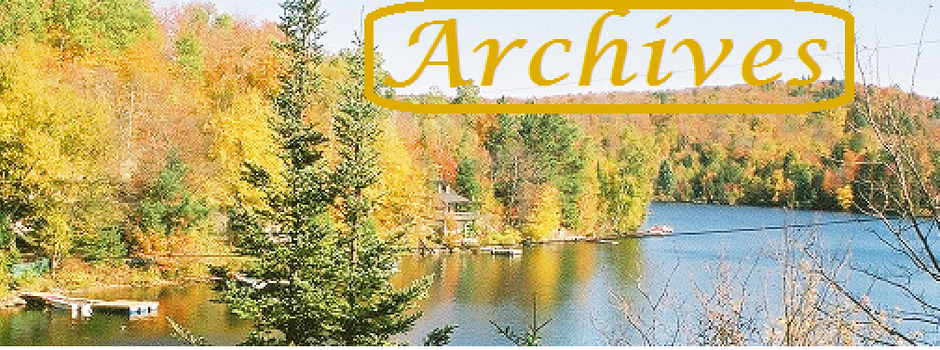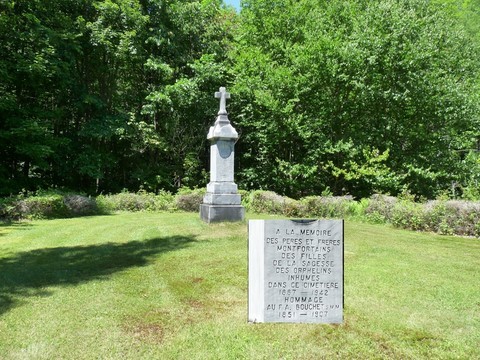ALSFX's 2010 Fall Newsletter
Montfort Leduc
With an historical connotation first name, the son of Eustache and Agnès Matte1 was the first male baby to have been baptized at Montfort in 1883; it is at least what asserts me his son-in-law, Jean-Louis Levasseur. I have just met this last one during my daily walk in Montreal. I had gone out with my camera this time. I had seen magnificent quite red shrubs the day before and I had to make a photo. «What do you photograph?” he asked while getting closer to me, whereas I aimed at six new towers of condos at the corner of Christophe-Colomb and of the Metropolitan. He lived there with his wife since three or four years.
I do not remember how Montfort came up in our conversation, but he said to me that he came at the orphanage as a teenager in 1945, for three years. His mother had died a few years earlier and the brothers of Sainte-Croix1 would have taken him at the institution. The “Filles de la Sagesse” were there also; that, I knew; I had read that they were from long ago in charge of the youngest, and also the kitchen, the laundry, the infirmary, etc. The orphanage on the actual site of Val Lisbourg3, however demolished since, now belonged to the government. The boys were very well treated there. At the head was a Father of Sainte-Croix; the chaplain was Father Ares, still living. People from the village would come at the institution chapel to assist at the Sunday mass. Many were climbing in the gallery forming a horseshoe around the nave, like at Montreal’s Notre-Dame Basilica.
The steam train arrived on Fridays. Among luggage, there were reels of film; the broadcasting took place on Fridays evenings for the public of the village and on Saturdays evenings for the orphans. It had repeat broadcast on Sundays when the weather was bad. The train was leaving on Mondays. We also played theatre and had concerts. We welcomed the quatuor Alouette.and the young prodigy Gérard Barbeau soprano singer famous here and abroad4.
He spoke to me about the small power plant, supplied in water from “Lake Saint-Francois” by a big water main of ringed iron wood of which we do not see more than concrete supports next to the village. I had rather believed it was for the original sawmill; however, that was at «the days of the Montfortains». There was a pond very close where they would go bathing. «And the small wooden bridge?” Yes, it was there also; but were we talking of the same one?
There were three clubs in which were grouped together the boys of diverse ages. Rotary from Saint-Jérôme financed many things among which three cottages at Lake Chevreuil in which met the groups. Did I know of Mount Pelé(e) near the orphanage? There was a ski tow there; you could reach the Lake skiing down the hill. He remembers having tried an off-run descent and having landed in the slush on the not completely frozen lake. His skis had broken and he would thus be deprived of those for certain time.
Rotary had offered a pair of skis to every young orphan and they were often skiing. On a sky trail not so far, one could reach the top of other hill and see St. Joseph’s Oratory, in Montreal. Was it also there that was situated that «one mile slope» as they were calling it? On their skis the boys could also go along Lake Chevreuil and down until reaching Morin Heights, just like today. There, the brothers would buy them chocolate bars at the restaurant5 and …a train ticket for their way back in Lisbourg!
The new church, now the Pavilion, had inherited from the furniture of the chapel of the orphanage: the altar, the benches, the small stained glasses framed by wood, I believe, etc. I told him that its two big bells had just been stolen. Next to the church was added a cemetery; there were already two older cemeteries, one for the brothers I think, the other for the nuns at Lake Chevreuil near the road. Some day he will show me where all those sites are, if we ever end there together (not at the cemetery…)
There was a farm near this road. The Leduc also had some cows. It was rare in the area; they took what they needed from those and the rest was for the orphanage. The brothers went by truck to Montreal every week and came back loaded with food and other products of necessity. There was a girls’ school; formerly, Agnès would occasionally replace the teacher. She rests now in the cemetery of the church. There was a hotel at the village; sometimes his mother-in-law was asked to sing there. Aged not much more than twenty years, she had a nice voice; however, she was not of the kind to go in such a place. She had met Montfort at the village; he was working at the orphanage. And he still spoke to me about the train. There was a railroad stop in front of the orphanage and the station farther at the junction of the other part of the Lake. One of his classmates was a Chartier; he was from the village; in winter, he would sky to school. Was he old Mr. Chartier I had recently seen with a saw in his hands? Had he worked on the orphanage huge wooden balconies?
They had gone to the institution foundation anniversary in the 80s. (It was undoubtedly in 1983 for the centennial, as well as for his father-in-law’s one, but he couldn’t believe the orphanage birth went back up in so far; for him, it was the work of the congregation of Sainte-Croix). There was a large audience that day. He kept the book published at that occasion, but it is in their cottage at Ferme-Neuve where Montfort and wife had move and where his own wife still has relationship. That’s where she had lived. Her grand-father Eustache had been buried there. But, she doesn’t like that strangers get involved in their business… They spend time there every year and to relax in winter for sure; it is not so far and it is ridiculous to close the cottage for that season and to reserve it only for summer to work on it all the time …
How was I going to be able to keep contact with Jean-Louis? I so needed him to learn the entire story from the mouth of someone who had lived it. However, he was very young at that time; that was years ago!
Carl Chapdelaine
1. Married in 1875, Eustache Leduc was the son of Eustache Leduc and Aurélie Cyr. After Agnès death, Cérilda Forget would become his second wife, in 1912. (Sources: Fernand Janson and Daniel É. Hombourger on GeneaNet.)
2. Holy Father André was a member.
3. Montfort village was then named Lisbourg for: Le Bourg des Industries Scolaires (L.I.S.); (source: Val Lisbourg web site). It was the Lisbourg orphanage.
4. Gérard Barbeau sur Youtube. Was Gérard related to the Superior?
5. One would call it a «corner store» today.
Loon’s Head and Agile Trout
We had nicknamed him Loon’s Head because he had done hair of feathers of this bird found on the bank of his lake, today Lake Saint-François-Xavier. With his daughter, Agile Trout, he was coming back from the South, from the Large River (“Ottawa River”) which comes down until Hochelaga. Naturally, he would never have approached alone this Iroquois village, or even the “Lake of the Two Mountains", of the time when his enemies of the Five Nations reigned there. They were themselves, members of the tribe of Weskarinis, Algonquins. Nomadic people, they lived on picking, hunting and fishing under protection of Great Manitou. Their territories were not suited for agriculture known to natives from the plain.
The winter camp of Loon’s Head and daughter at feet of our majestic lake contained about twenty persons. Their ancestors frequented it probably for a long time. From there, they could either come down the steep slope towards the "Lake Chevreuil" and, by taking the “Rivière-à-Simon", go until "Rivière-du-Nord", where were established other tribes of Weskarinis. They could, on the contrary, go back on their lake to join Lake Saint-Victor and then a small river which connected them to other members of their tribe settled throughout the valley of the Red River and its tributaries.
They had spent the summer in a camp near the mouth of the river of the Petite-Nation. It is exactly the name which the French people were to give them, maybe because they lived in small groups contrary to Iroquois often settled in small villages. Near this place, now Plaisance, they found number of Petite Nations’ members. These were otherwise scattered more in the North during the winter, on vast territories of hunting, in those "Pays-d'en-Haut", near streams they would navigate to gather on the Ottawa River. They welcomed there also Algonquin gone down from even farther on the Big River, the Kitchesippi1. They practised also, for a long time, trades with the other friendly native people there.
They had come down in spring by an endless path and waterways on which they were carried, for the water destination was also theirs. The road had been used by others, even well before them, and it brought them to cross several lakes where of the relationship had to welcome them. They so joined the Ottawa River where their light bark canoe would allow them a big mobility throughout the nice season. There also could Agile Trout meet a suitor and some day, fall being in sight again, not maybe take back the same road as her father.
Now that the time was on the way back towards their lake, no river was going to want to carry them; it would be necessary to walk between every lake which they would see again on their road. Then, once income in their winter camp, they should with the others begin hunting full-time and making ample reserve of game, fish, wood and the other resources of their environment which allow them to face and to survive the cold season. It would also be necessary to trap and to get ready the skins of beavers and other mammals used for the exchange of furs with newcomers in the big valleys of the South, the French people.
Would their stay on the edges of the Ottawa River also bring them to meet the Ouendats (Huron) chased away from the “Georgian Bay”2 by the Iroquois and with whom their nation had become allied? With, besides, Montagnais from the East, they were moreover going to enter the camp of the French people and they would obtain protection from them against their traditional enemies. The history was going to announce the defeat of the French people against the English and their own disappearance, by 1653, under the attacks of their wild opponents. Better armed, these last ones had already just sealed the fate of the Huron. Number of their territories would for a long time, it seems, be deprived of any population until the colonization by White people. The native lifestyle in the Laurentians had vanished.
1. Signifying big river in Algonquin. The name Ottawa was attributed to other native tribe.
Source: Some of the historic facts are from "Les Laurentides" by Serge Laurin, editions of the IQRC. Loon feathers and situation on our lake are from the undersigned.
2. Mattawa River, an Upper Ottawa River tributary, allows crossing in Lake Huron’s watershed. It was on the road of furs, Montreal up to Lake Athabaska (in Alberta).
By Carl Chapdelaine










